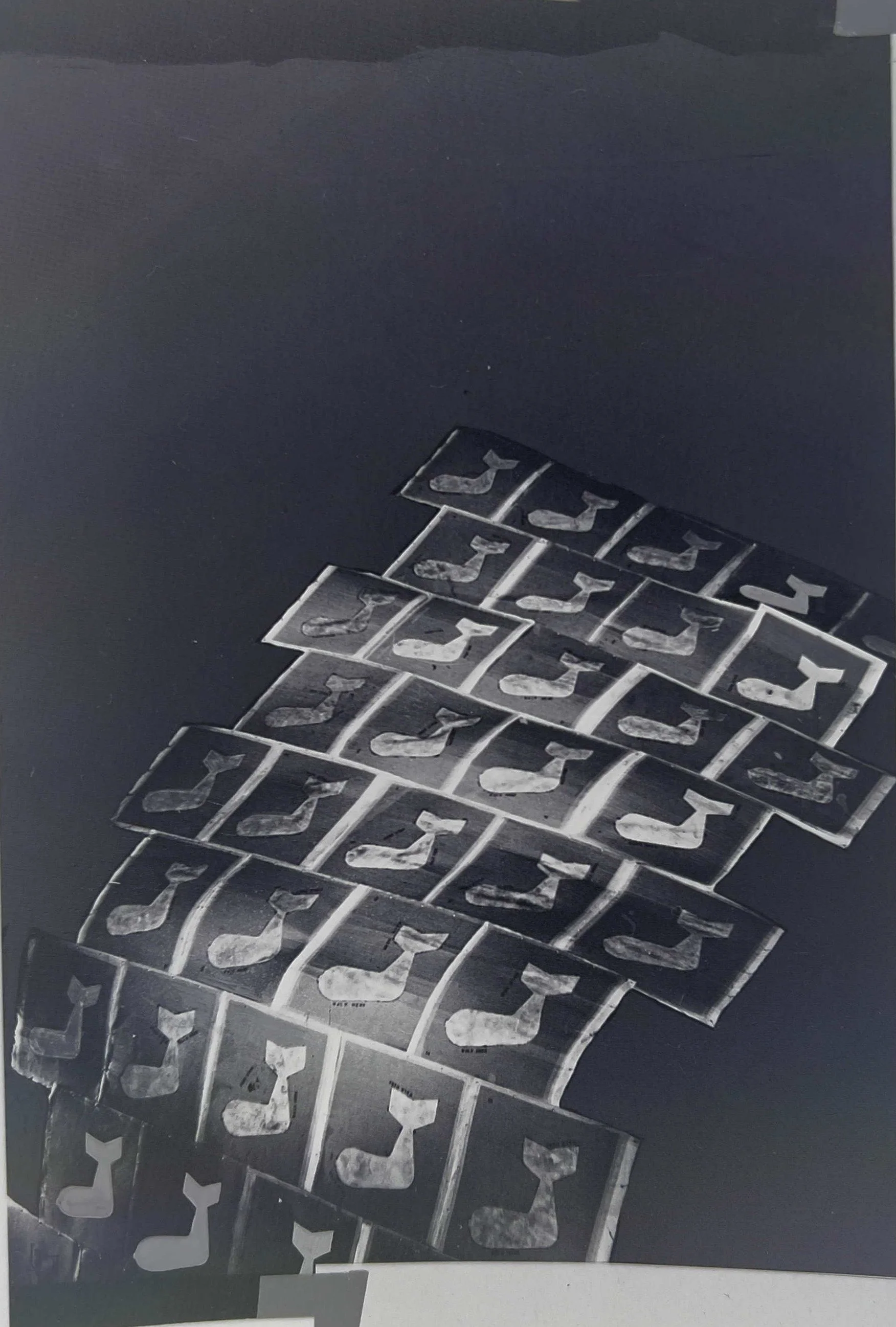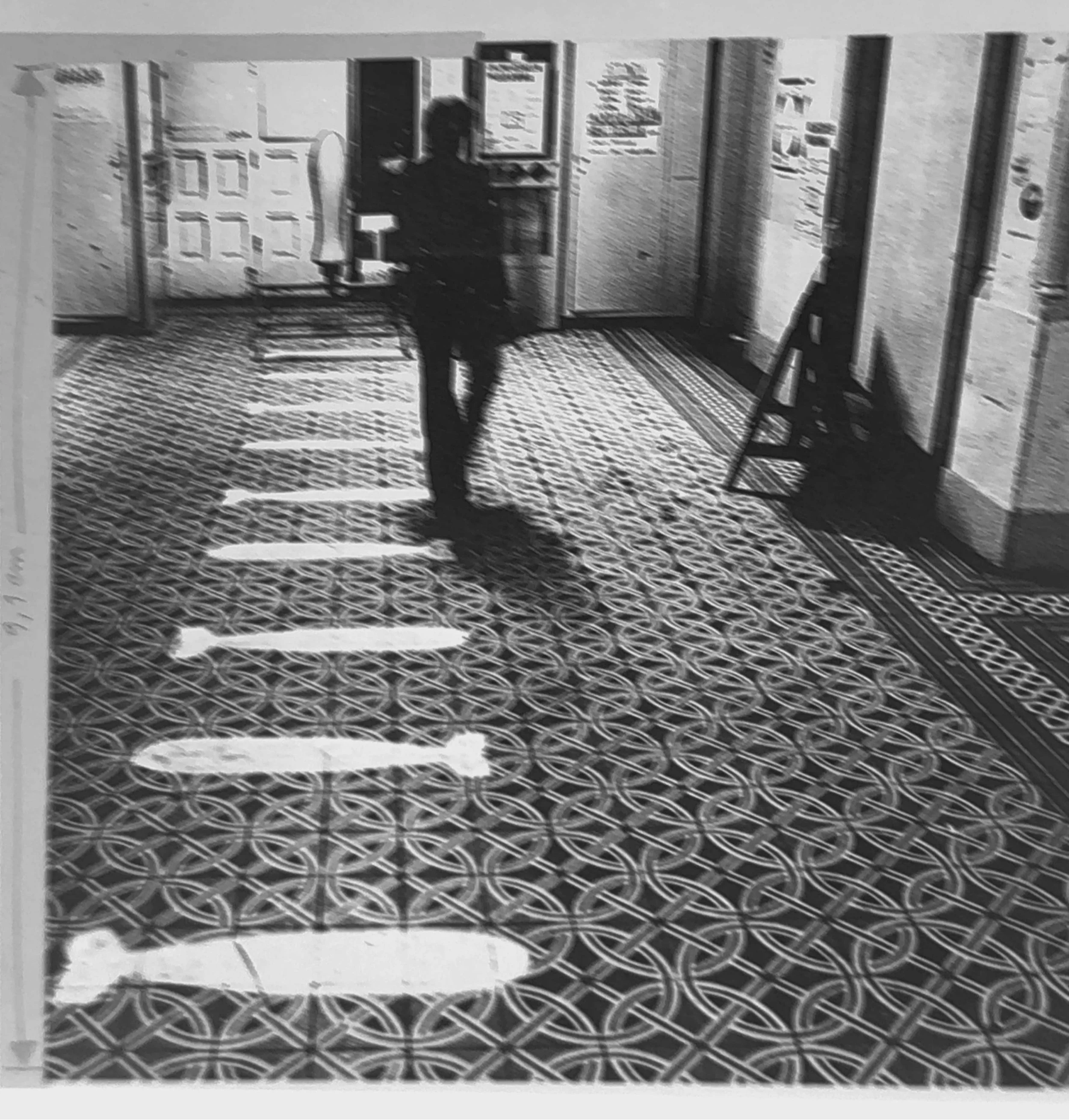Rug for Rent
“The rapid succession of name changes of the bomb project shows how intensively Van den Berghe is concerned with this theme. Started in 1972 under the cynical term "Our friendly bombs", he calls the project "Rug for rent" the following year, and in one of our last conversations he comes up with the more historicizing name "Step by step rug making". For practical reasons, however, it is then no longer possible or even desirable to give this new title to the exhibition.
In the phase of "Our friendly bombs", cardboard sheets, each measuring 100 x 100 cm, are laid on the road surface at various locations in New York, for example in the Lower East Side or at the bottom of the escalators of Grand Central Station, and attached to them with tape. A piece of painter's canvas, also measuring 100 x 100 cm, is placed between the road surface and the cardboard sheet. A space (template) is cut out in the ribbed cardboard in the shape of a bomb. The cut-out space, under which the linen now appears, is smeared with Mixtion, a glue that is also used for frescoes and that retains its adhesive power for 12 hours. As people walk over it, imprints are created on the canvas with dust from the streets of New York.
When the corrugated cardboard is removed from the canvas, the bomb painting appears. In this way, anonymous people more or less unconsciously participate in the production of projectiles, weapons of destruction. It is this "Aufklärungs" task with regard to the anonymous joints in our society that is significant in all of Van den Berghe's activities. In this context, we could certainly speak of an educational artistry, if the word "educational" had a somewhat more playful and provocative emotional value.
There are two types of bombs: the American bomb, male, and the European bomb, female. The latter projectile differs from the former in that it was made in Europe and has two bomb points. Van den Berghe also called these "friendly bombs" boomerang bombs: they return to the place where they were produced. They are friendly insofar as they cannot explode; on the other hand, they are explosive insofar as they contribute to awareness of what war violence far from home actually means. This carpet of bombs was exhibited in an annex room of the Whitney Museum in New York.
Poster Rug for Rent, Museum Hedendaagse Kunst, Utrecht, 1974.
Design board Bommentapijt.
Postcard Friendly Bombs from Roland Van den Berghe to Karel Geirlandt, 14 August 1972. Archive of Toni Geirlandt.
Peggy Guggenheim's son-in-law performed the vernissage there by ripping the cardboard from the canvas and tearing it, causing the bombs to explode, as it were. Because Van den Berghe wanted to confront his bombs with Picasso's Guernica, the Museum of Modern Art was also involved in this action. However, the museum's management was not prepared to grant permission for this. That is why Van den Berghe resorted to a ruse. Two men each stand with a bomb painting in front of the Guernica, while two photographers are there to take pictures: a white man and a black man. "Only the black man had film in his camera. Because people always go after the white man first, people are a bit more careful with people of color, they fear a race riot. While they were getting rid of the white man, the black man could take a few pictures and disappear.
" This American carpet of bombs, consisting of 50 paintings attached to each other, hung in Paradiso in Amsterdam in 1972. On the evening that the TV results of Nixon's re-election as president of the United States were broadcast, Van den Berghe laid out a European carpet of bombs consisting of 50 paintings on the floor. People walked, danced and watched television on it. At the end of the evening, the surface on the floor, in the shape of the 50 stars as they appear on the American flag, was pulled up on one side until it was at an angle of 70° with the sloping American carpet. With this, Van den Berghe indicated how he sees the relationship between the US and Europe: America (man) above, Europe (woman) below. Different in mentality, but both continents hinge on the same corruption of power and violence.
At this exhibition in Contemporary Art, 50 American and 50 European bomb paintings are exhibited. They are alternately attached to each other and exhibited like a Persian carpet in a showroom. This "unshaped canvas" is 10 meters wide and 10 meters long. In this way, he degrades the museum to a carpet rental company. The museum is pulled towards and into the street as a showroom for passers-by.”
Translated from the Dutch text: 1974, Catalogue of the exhibition Rug for Rent, Museum Hedendaagse Kunst, Utrecht.
Photo Bommentapijt, RAI, Amsterdam, 1986.
Design drawing Their Friendly "Miss Europe", Paradiso, Amsterdam, 7 November 1972.
Postcard Friendly Bombs from Roland Van den Berghe to Karel Geirlandt, 14 August 1972. Archive of Toni Geirlandt.
Timeline
1968
Drawings suitcases with bombs (untitled).
1972
Our Friendly Boomerang, Whitney Museum and in the streets of New York. People were asked to simply walk over templates of boomerang bombs that Van den Berghe had laid on the ground. In this way he collected hundreds of 'bombs', made with American fabric and American footprints.
1972
Guernica, MOMA, New York. He placed a few of these bombs near Picasso's 'Guernica', thus creating a confrontation between two visual protests against the war.
1972
Their Friendly "Miss Europe", Paradiso, Amsterdam.
The European series, "Their Friendly Miss Europe", was made in Paradiso in Amsterdam on the evening that the news about the re-election of Nixon as president of the US was broadcast on television. The American carpet was then attached to the ceiling. At the end of the evening, the European plane lying on the ground was pulled up on one side while the American plane on the same side sank towards the rising plane until they both formed a corner.
1973
Drawings Snails in charcoal on paper.
1973
Publication Playing card set, based on Our Friendly Boomerang and Their Friendly Miss Europe. The photos taken in New York were printed on the back of the playing cards.
1974
Conversation between John Aleks, Ellen Sragow and Roland Van den Berghe in New York.
1974
Exhibition at De Moriaan in Den Bosch.
1974
Rug for Rent, Museum Hedendaagse Kunst, Utrecht.
1974
Our Friendly "Boomerang" - Their Friendly "Miss Europe", Wittenborn & Co, New York, NY.The playing card set was distributed in the United States by Wittenborn & Co.
1981
Kunst in / als vraag, provinciaal Museum voor Moderne Kunst, Lakenhalle in Ieper.
1984
O PER A, participation projects 1967-1984, Technicshe Universiteit Eindhoven.
1986
The Fool, The ninth annual scientific meeting of the International Society of Political Psychology, International Congress Centre RAI, Amsterdam.
Poster Their Friendly Bombs – Our Friendly Bombs, Paradiso, Amsterdam, 7 November 1972.






















